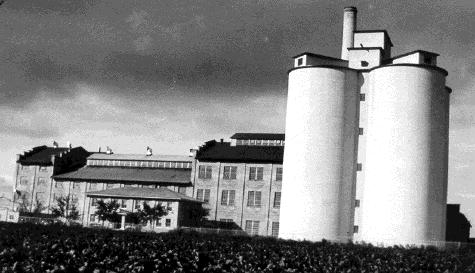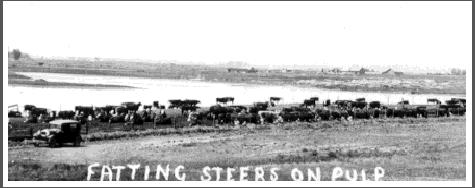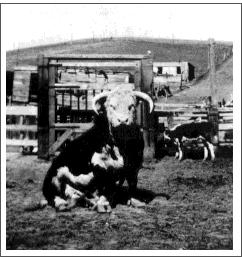Sugar Beet History plus Photographs of Sugar Beet Farming, near Sidney, MT in early 1930s
Last Updated: 9 Oct. 2001

written by Judy A. Remmick-Hubert
Information and photographs from Lillian, nee Hein, Remmick
Where did the beet come from? From what I understand, the root crop descended from wild sea-beet which was used by the Romans as food for themselves and their animals.
In medieval times and early modern Europe, the root was mainly used for animals.

Holly Sugar Factory, Sidney, MT in 1930s
In 1747 and a Berlin Professor, Andreas Margraf, successfully extracted sugar from beets. His student, Franz C. Achard, improved the beet for it's sugar content by using the Silesian beet. In 1800 the King of Prussia built the world's first sugar-beet factory. Although not financially successful, other Prussians followed suit and built factories in Silesia and near Magdeburg. In 1801 / 1802 Russia was the second country to become part of this new industry.
About this time, Napoleon's influences entered the history of sugar beets. At first his sugar came from his sugar cane fields in the French Caribbean colonies... He banned sugar from the British with whom he had been at war. When Napoleon lost the Caribbean island which had produced his sugar from the cane, he had to look elsewhere. He was introduced to sugar from beets. He requested the landowners in France and the countries north of the Alps to grow beets for sugar. Because of the beet's lack of tolerance to the wet ground in these areas, yield was not worth the effort. Not until the beet was improved.....and, not until procedures changed because of Mathieu de Dombasle suggestions, did the beet become a product worth the effort to grow for profit. Improvements continued... Beets became part of the agricultural rotation and the leaves [beet tops] provided cheap feed for animals and increased livestock.
The first beet seeds were imported into the USA to New England in 1879 and 1882.
The first sugar beet factory appeared in North American in California in 1869, the Flint, Bixby and Co. but this industry didn't spread to other areas until the 1880s.
The beet appeared in the mid-western USA [Colorado, western Nebraska into North and South Platte Valleys] at about the same time as German-Russians , who knew about sugar beets, had migrated into these areas.
The first sugar factor in MT was built in Billlings in 1906.... The early emigrants were brought to the fields by train... Taken to fields by wagon... They would return to the towns and cities where their families still lived when the season's harvest was completed for the year. Soon men brought their families along with them to work in the fields.... The more members of the families [parents and children] who could work the fields meant the family made more money for the family.... Some families, like the Hein family, earned enough money to be able to purchased land of their own and they grew their own beets... They used emigrants who came to their fields.... Like the Ludwig Hein family, some prospered and larger tracts of land were purchased...

An old postcard with these words written on it: "Fatting Steers on Pulp, Holly Sugar Factor, Sidney, Mont. 37.
Sugar beets isn't all that Ludwig Hein raised. He also had cattle which he fed the sugar beet pulp which proved to be a cheap fodder and very successful in producing excellent beef.

One of Richard Hein's prize Bulls
Back of the photograph reads:
"WHR Prodigy 1st, Chief Herd Sire, F.S.P. Foss, Glendive, Montana"
The sugar industy is highly protect here in the USA where a domestic price for sugar beets or cane is maintained.
In present day beet farming in our mid-west states, the yield per acre is about 22 to 28 tons with about 17 percent sugares can be gained with good managment.
Having discovered beets are a good rotation crop to control diseases, it is generaly rotated wtih corn, beans, cereals and forage legumes.
The crop is planted in early April or when soil moisture and temperature allows.
Rows width is about 30 inches wide with thinning performed later.
Weeds must be removed either by hand or with herbicides.
Insectcs which attack beets are beet root magots, sugar beet root aphids, cut worms, beet armyworms, beet wwebwores, beet leafhoppers and grasshoppers. There are also nematode of various kinds.
If insects weren't enough, there are various diseases that can atttack the beet. Both fungi and viruses can ruin a crop.
If a farmer's beets survive to harvest in the fall (Sept to Oct.). This means, the beet must be topped, uprooted which is called lifting, placed into trucks and hauled to the factory where it is stored in huge piles.
One cannot leave the root in the ground because the freeze will destroy it and it will rot.
For more information see the following web sites:
http://agronomy.unl.edu/ffa/SugarBeet.htm
http://www.cup.org/Books/Kiple/sugar.htm
-
Hubert Home Site
|
RemMick HomeSite
|

|
Hein Genealogy |